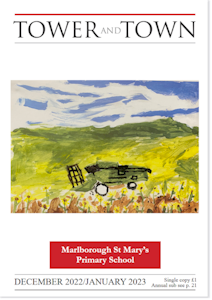

Tower and Town, December 2022 (view the full edition) (view the full edition)Nature Notes‘Nature’s Christmas Benison’ Winding through a pathway in Savernake Forest recently, I was amazed to find a crop of sweet chestnuts under my feet, and the scent of them roasting on our fire later set me thinking about nature’s rich contribution to December and the Christmas season. There were acorns there too, and the sound of a hungry jay calling nearby, ready to start his winter cache. A nuthatch is another nut-hoarder, tucking away nuts into tree-bark, and sure enough I heard his loud “pwit-pwit” call a little later. Raw acorns are no good for eating but a friend reminded me that they were cooked and ground, then used as a pale substitute for coffee in the War: nowadays they often feature in Christmas decorations. We often find a few sprigs of holly in the forest in early December and then wonder what has happened when we return to the same trees just before Christmas-somebody has got there first or else the thrushes have stripped them bare! Ivy is easier to find, even in your garden or down the lane: its long tendrils make it ideal for wreaths and garlands.
At the high table the Boar’s Head in the famous carol is “bedecked with bays and rosemary” as well as “a gay garland.” “In gentlemen's houses at Christmas”, a 17th C writer commented, “the first dish that was brought to table was a Boar's head, with a lemon in his mouth." The Boar's Head Dinner at Queen's College Oxford on Christmas Day is a survival of a custom once prevalent in all England. Now we eat turkeys, geese or duck instead, thankfully not swans, a favourite dish at Henry the Eighth’s table. In “The twelve days of Christmas” there are two turtle doves-you will be lucky to see one in Wiltshire now, for their numbers have declined drastically across the U.K. Various wilding projects have had some success with the species, for example in Essex and Norfolk. Finally there’s the Christmas Tree with a robin on top, looking good and smelling good, a natural centrepiece for the celebration of Christmas. Robin Nelson |